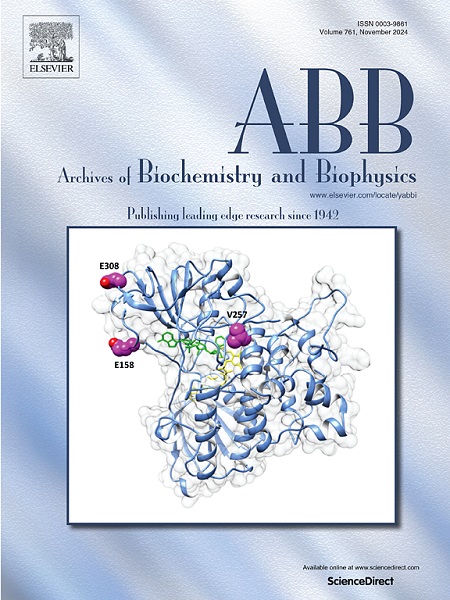使用基于protac的方法降解突变体IDH1损害STAT3激活。
IF 3.8
3区 生物学
Q2 BIOCHEMISTRY & MOLECULAR BIOLOGY
引用次数: 0
摘要
IDH1(异柠檬酸脱氢酶1)的杂合突变在大多数II级和III级脑肿瘤中发现。在脑肿瘤中发现IDH1突变后不久,就发现了大量突变的IDH1抑制剂。但最近的报道显示,突变型IDH1抑制剂逆转了治疗脆弱性,并激活了表达IDH1的突变细胞中的致癌转录因子STAT3。因此,使用IDH1突变体特异性抑制剂抑制IDH1突变体可导致耐药性。因此,为了阻断突变的IDH1,必须确定替代的治疗模式。在这些方面,最近的研究结果表明,靶向嵌合体的蛋白水解(PROTAC)分子可以被设计来降解癌细胞中的靶蛋白。然而,降解突变体IDH1是否会导致STAT3激活尚不清楚。因此,在本研究中,我们询问通过采用基于protac的方法降解突变体IDH1是否会导致STAT3激活。为了回答这个问题,我们采用了dTAG系统,将FKBP12F36V与突变体IDH1蛋白融合,并使用FKBP12F36V特异性PROTAC dTAG-13来降解突变体IDH1-FKBP12F36V。我们评估了表达突变体IDH1-FKBP12F36V的dtag -13处理细胞中STAT3的激活情况。我们发现,将FKBP12F36V-HA与突变体IDH1融合后,突变体IDH1具有相似的表达水平、酶活性和细胞定位。我们观察到dTAG-13以剂量和时间响应的方式降解突变体IDH1-FKBP12F36V-HA。与抑制不同,降解突变体IDH1-FKBP12F36V-HA不会导致pSTAT3-Y705激活。我们得出结论,采用基于protac的方法降解突变体IDH1会损害STAT3的激活。基于这些观察结果,我们建议可以开发突变型IDH1特异性PROTACs来降解胶质瘤中的突变型IDH1。本文章由计算机程序翻译,如有差异,请以英文原文为准。

Degrading mutant IDH1 employing a PROTAC-based approach impairs STAT3 activation
Heterozygous mutations in IDH1 (isocitrate dehydrogenase 1) are found in most grade II and III brain tumors. A slew of mutant IDH1 inhibitors were identified soon after the discovery of IDH1 mutations in brain tumors. But recent reports show that mutant IDH1 inhibitors reverse therapeutic vulnerabilities and activate the oncogenic transcription factor STAT3 in mutant IDH1-expressing cells. Thus, inhibiting mutant IDH1 using mutant IDH1-specific inhibitors can result in drug resistance. Therefore, to block mutant IDH1, it is imperative to identify alternative modes of therapy. In these lines, recent findings show that PROteolysis TArgeting Chimera (PROTAC) molecules can be designed to degrade target proteins in cancer cells. However, it is unknown whether degrading mutant IDH1 leads to STAT3 activation. Therefore, in this study, we asked if degrading mutant IDH1 by employing a PROTAC-based approach leads to STAT3 activation. To answer the question, we adopted the dTAG system, where we fused FKBP12F36V to mutant IDH1 proteins and used the FKBP12F36V-specific PROTAC, dTAG-13, to degrade mutant IDH1-FKBP12F36V. We assessed STAT3 activation in dTAG-13-treated cells expressing mutant IDH1-FKBP12F36V. We found that fusing FKBP12F36V-HA to mutant IDH1 phenocopies mutant IDH1 with similar expression levels, enzyme activity, and cellular localization. We observed that dTAG-13 degrades mutant IDH1-FKBP12F36V-HA in a dose- and time-responsive manner. Unlike inhibiting, degrading mutant IDH1-FKBP12F36V-HA did not lead to pSTAT3-Y705 activation. We conclude that degrading mutant IDH1 by employing a PROTAC-based approach impairs STAT3 activation. Based on these observations, we suggest that mutant IDH1-specific PROTACs can be developed to degrade mutant IDH1 in gliomas.
求助全文
通过发布文献求助,成功后即可免费获取论文全文。
去求助
来源期刊

Archives of biochemistry and biophysics
生物-生化与分子生物学
CiteScore
7.40
自引率
0.00%
发文量
245
审稿时长
26 days
期刊介绍:
Archives of Biochemistry and Biophysics publishes quality original articles and reviews in the developing areas of biochemistry and biophysics.
Research Areas Include:
• Enzyme and protein structure, function, regulation. Folding, turnover, and post-translational processing
• Biological oxidations, free radical reactions, redox signaling, oxygenases, P450 reactions
• Signal transduction, receptors, membrane transport, intracellular signals. Cellular and integrated metabolism.
 求助内容:
求助内容: 应助结果提醒方式:
应助结果提醒方式:


